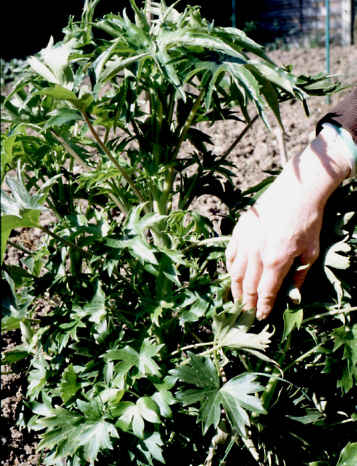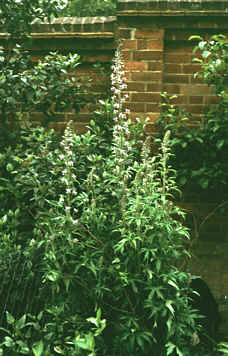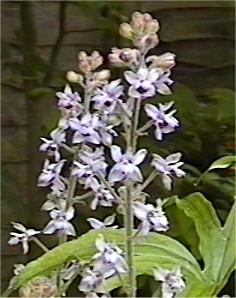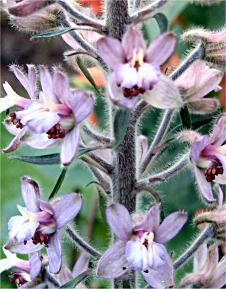Delphinium
requienii
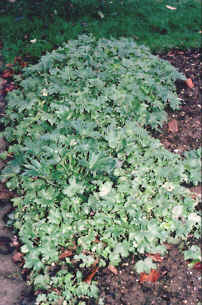 This delphinium is a biennial and
originates from the Isles d'Hyeres (S. France), Corsica and
possibly Sardinia. It would be rather surprising if a species
from these locations was completely hardy. In our experience over the last
twenty years, small seedlings do survive most winters in Britain
and then provide an interesting flower display the following
summer. The plants
are prolific seed producers and hundreds of self-sown seedlings,
as seen in the picture, ensured that this delphinium could be
found somewhere in our garden almost every year.
This delphinium is a biennial and
originates from the Isles d'Hyeres (S. France), Corsica and
possibly Sardinia. It would be rather surprising if a species
from these locations was completely hardy. In our experience over the last
twenty years, small seedlings do survive most winters in Britain
and then provide an interesting flower display the following
summer. The plants
are prolific seed producers and hundreds of self-sown seedlings,
as seen in the picture, ensured that this delphinium could be
found somewhere in our garden almost every year.
Seedlings of D. requienii
can be transplanted without difficulty, so it is easy to lift and
pot them up so that some can be given greenhouse or cold frame
protection during the winter.
The seeds are large compared to
those typical of cultivated garden delphiniums. Sown in moist
multi-purpose compost, germination occurs in 14 to 21 days when
the seed tray is kept at 15 - 20°C. It is important to keep seed
trays in good light once germination starts, otherwise the stems
of seedlings extend extremely quickly. This year during March,
for example, seedlings kept on a window ledge grew 50 - 75 mm
tall in about 3 days! It would have been better to transfer the
pots to the greenhouse to obtain sturdy seedlings despite the low
temperatures. Seedlings are pricked out once the first true leaf
is well developed. At this stage, the fleshy stems and
characteristic glossy leaves are already apparent and the plants
soon grow quite large, even at low temperatures.
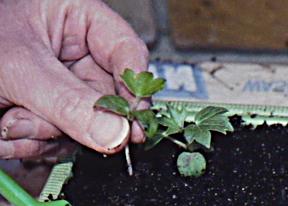 |
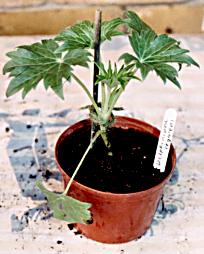 |
If seedlings in the open ground
grow too large before the onset of winter, they become prone to
attack by botrytis, especially after snowfalls. It is possible
that the initial tissue damage is caused by freezing. During the
past winter, two large plants with stems 50cm tall and 25mm thick
that had almost reached flowering by late October were killed by
frost during January. The large leaves looked undamaged but the
fleshy stems collapsed and rotted.
Seedlings that survive through
the winter develop to very large plants up to 2 m tall with many
branches and side spikes when growing in fertile soil. In a dry
inhospitable site they remain dwarfed at perhaps 30cm tall but
will still flower and set seed. When handled, the large fleshy leaves have an
unpleasant odour which reminds us that delphiniums are poisonous.
Each plant develops a long
terminal raceme or flower spike with many fairly small florets.
Vigorous plants also develop several large secondary flowers
spikes from leaf axils on the main stem. Further smaller
flowering branches develop in succesion from almost every leaf
joint on the plant so that a plant may have hundreds, perhaps
thousands, of individual florets. The flowers are very attractive to bees, and a group of
plants in flower can have hundreds of bees buzzing around.
The florets are about 25mm
across with a spur about half the length of the sepals, which are
pale pinkish-violet in colour with purple veining on the back
surface. The prominent group of dark purple stamens add to the
curious charm of these flowers. As the pictures show, the flowers
and stems are clothed in fine hairs.
After pollination, each floret
develops three carpels containing ten or more seeds. Flowering
extends over many weeks due to the development of flowers on
lateral and sub-lateral branches but the plant dies when
flowering is over.
Clonal variation During the past year, plants of D.
requienii from two sources were grown from sowings in
February. Plants raised from our own seed made a lot of growth
but without signs of flowering. Another batch raised from seed
from the Hardy Plant Society (labelled as D. staphisagria)
differed in several respects. At all stages, the form of the
plants in the two groups was identical, as were the flowers, but
the foliage of the HPS batch was a much darker green and there
was heavier purplish staining of the stems. The plants of the HPS
batch also all developed flower stems and many flowering
sideshoots, although the flowers were destroyed by wet conditions
and grey mould (botrytis) during October. Several plants in both
batches were lost due to the development of black rotting regions
in the thick fleshy stems at the soil surface during the summer.
 This delphinium is a biennial and
originates from the Isles d'Hyeres (S. France), Corsica and
possibly Sardinia. It would be rather surprising if a species
from these locations was completely hardy. In our experience over the last
twenty years, small seedlings do survive most winters in Britain
and then provide an interesting flower display the following
summer. The plants
are prolific seed producers and hundreds of self-sown seedlings,
as seen in the picture, ensured that this delphinium could be
found somewhere in our garden almost every year.
This delphinium is a biennial and
originates from the Isles d'Hyeres (S. France), Corsica and
possibly Sardinia. It would be rather surprising if a species
from these locations was completely hardy. In our experience over the last
twenty years, small seedlings do survive most winters in Britain
and then provide an interesting flower display the following
summer. The plants
are prolific seed producers and hundreds of self-sown seedlings,
as seen in the picture, ensured that this delphinium could be
found somewhere in our garden almost every year.

